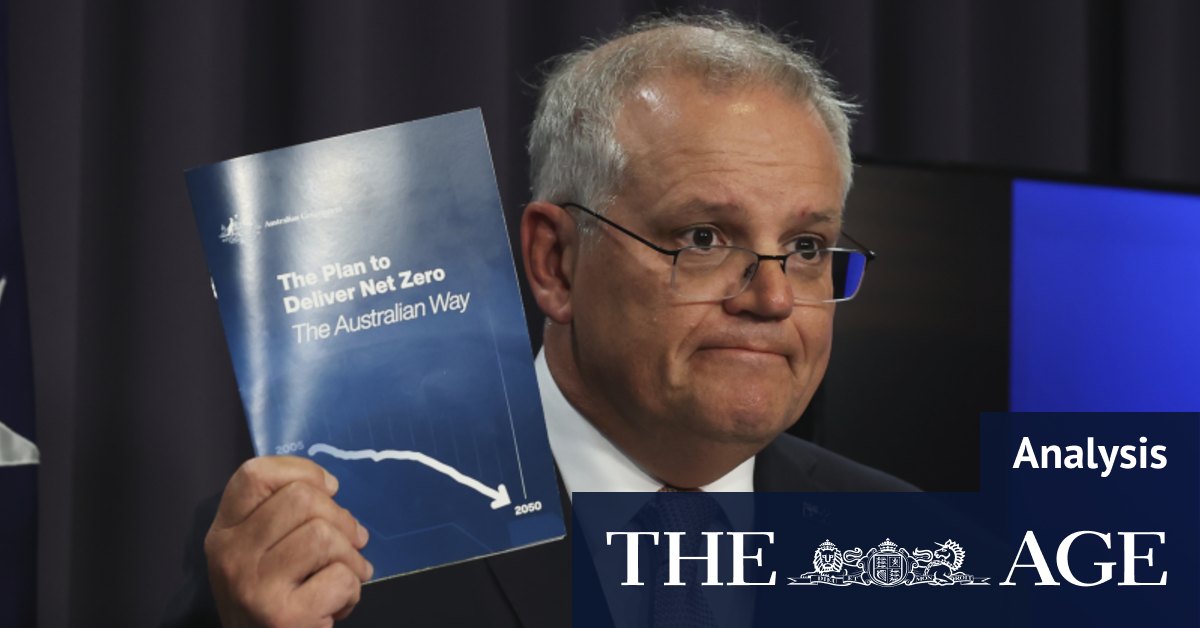Bare bones Emissions plan heavy on promises but light on detail

Less than a week from the Glasgow climate summit, the government has agreed a net zero by 2050 deal with the Nationals.
Under the tagline “The Australian Wayâ€, Prime Minister Scott Morrison has released a plan he says will guide Australia, one of the world’s highest per-capita greenhouse gas emitters, towards a low-carbon future. So, how does it stack up?
What’s in ... and what’s notThis plan makes many promises: it won’t impose a carbon tax or penalise carbon-intensive “traditional industriesâ€. It won’t trigger job losses, and Australia’s coal and gas exports will continue to 2050 and beyond. It includes pledges not to raise the price of energy or impose new costs on households, businesses or regions.
What’s notable is what the plan doesn’t include, such as a shift away from subsidising and expanding Australia’s fossil fuel industry and export market. Nor does it include any new legislation or policies, renewable energy targets or industrial energy efficiency targets. The modelling used to develop the plan has not been made public, and Prime Minister Scott Morrison said during question time on Wednesday that it would not be released to the public for a “couple of weeksâ€.
“It’s completely silent on the fact that we must transition out of mining, exporting and burning gas and coal, and move to a 21st-century way of powering our country,†says Professor Lesley Hughes from Macquarie University, also a councillor with the Climate Council. “You can’t have your cake and eat it too.â€
No further cuts by 2030Scientists and climate experts say Australia and the world need to make deep cuts of 50 per cent (on 2005 levels) or more to greenhouse gas emissions by 2030 to have any hope of reaching net zero by 2050. This is not part of the government’s plan.
Mr Morrison says the existing target of a 26-28 per cent cut will be exceeded, with an expected reduction of 30-35 per cent. But nearly all the cuts since 2005 came when Labor was in power, mostly due to changes in state land-clearing laws. Further emissions reductions have been driven by the states embracing renewable energies.
There’s little credibility in a net 2050 target that doesn’t bend the curve as quickly as possible. A goal of 50 or 60 per cent emissions cuts by 2030 would allow time to speed up the electric vehicles transition and further bolster the booming wind and solar renewables sector.
Climate Analytics chief executive Bill Hare says the plan does not compare favourably with other global strategies such as that of the European Union, which lays out a clear pathway to net zero by 2050 and the modelling to get there.
“Australia’s plan is very meagre actually, it’s quite empty,†he says. “If you know the field and know what other countries are doing, it really is bare bones.â€
Tentative technologyThe federal government says “technology not taxes†will be used to bring down greenhouse emissions and has pledged $20 billion to develop low-emissions tech over the next decade. The plan calculates almost one-third of emissions reductions by 2050 will come from unnamed and unspecified “global technology trends†and “further technology breakthroughâ€.
Some of this technology, such as green hydrogen, is still prohibitively expensive and requires considerable development, while carbon capture and storage is controversial and largely unproven at scale.
Billions have been spent on carbon capture and storage â€" where emissions are captured on site and pumped underground â€" with little success to date. Chevron, the operator of Australia’s only commercial-scale carbon capture and storage project, said this year the project has failed to meet its targets by about 70 per cent.
Time is running out, says Hare. “We can’t just wait for technology to evolve and do this for us, we have to create the policy frameworks.â€
Offside on offsetsTo get from 615 million tonnes of carbon emissions produced in 2005 to zero in 2050, the plan assumes that 10 to 20 per cent of this dramatic drop will be achieved in two ways: first, through carbon offsets, when individuals or companies invest in environmental projects to offset their emissions; and by removing greenhouse gases from the atmosphere through tree planting and sequestering carbon into the soil.
The plan assumes Australia can generate, through tree planting alone, 63,000 million tonnes of carbon credits by 2050, which works out at 42 tonnes of carbon dioxide per hectare, per year.
This is a “nonsenseâ€, says Polly Hemming, an expert in carbon offsets from the Australia Institute, an independent think tank.
“That’s physically impossible. Even in the most fertile areas, the ash forests with 100-metre tall trees, the maximum you can probably ever get is 19 tonnes.â€
0 Response to "Bare bones Emissions plan heavy on promises but light on detail"
Post a Comment